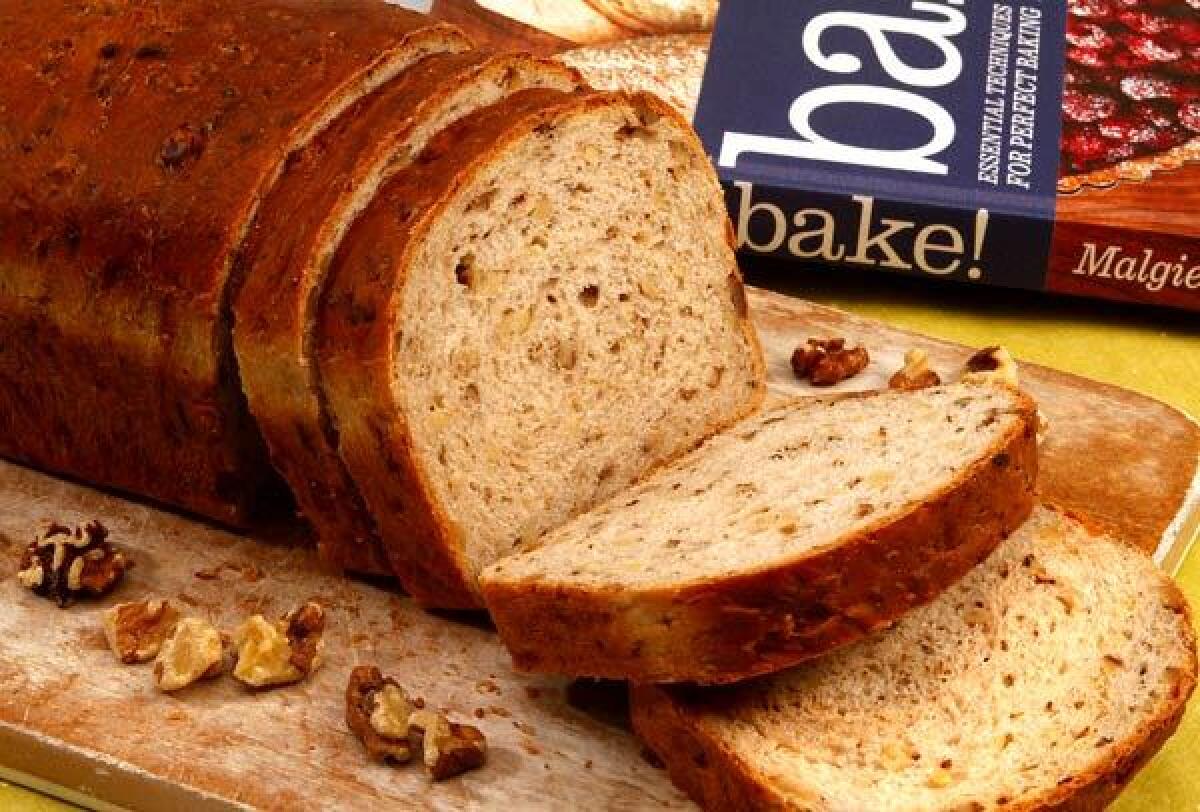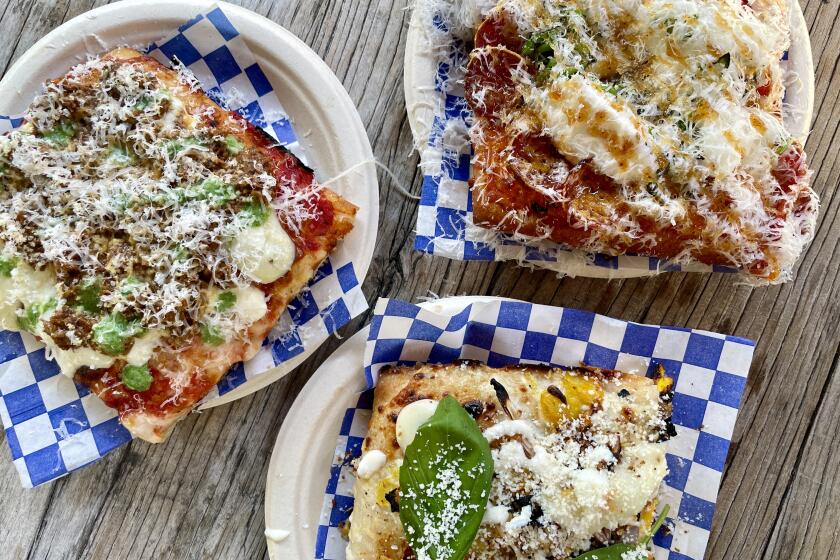Recipe: Gruyère and walnut bread

This bread is so delicious, it’s hard not to eat a whole loaf at once. Good thing this recipe — from veteran baker Nick Malgieri’s latest book, “Bake!” — makes two loaves. The book made it on our list of this year’s “10 Great Books,” at least partly because of his Gruyère and walnut bread. It’s spiked with a little freshly ground pepper, a kicky complement to the Swiss Gruyère cheese and toasted walnuts. It’s also not easy waiting for it to cool before you slice into it.
Gruyère and walnut bread
Total time: About 1 1/2 hours, plus rising and cooling times
Servings: 16 to 20
Note: Adapted from “Bake!” by Nick Malgieri. This recipe requires the use of a stand mixer.
6 1/2 cups bread flour (spoon into a dry measuring cup and level off)
1 tablespoon sugar
1 tablespoon salt
2 teaspoons coarsely ground black pepper or crushed red pepper, optional
1/4 cup (1/2 stick) butter, cut into 8 pieces, plus optional extra melted butter for brushing on the finished bread
1 1/2 cups milk, scalded
1 cup warm water, about 110 degrees
2 1/2 teaspoons (1 1/4-ounce envelope) active dry yeast
2 cups loosely packed coarsely grated Swiss Gruyère cheese
2 cups chopped walnuts, lightly toasted
1. Butter or grease 2 9-by-5-by-3-inch loaf pans.
2. In a large bowl, stir together the flour, sugar, salt and pepper. Set aside.
3. In a small bowl (or the pan in which the milk was scalded), stir the butter into the hot milk. Cool the milk to room temperature.
4. After the milk has cooled, pour the water into the bowl of a stand mixer and whisk in the yeast. Wait 1 minute, then whisk again to make sure the yeast is completely dissolved. Whisk in the cooled milk and butter mixture.
5. Use a large rubber spatula to stir in about half of the flour mixture. Stir in the rest of the flour in 3 to 4 additions to form a rough dough in which there is no longer any unmoistened flour.
6. Fit the bowl onto a mixer fitted with a dough hook, and beat on medium speed until the dough is somewhat smoother but not perfectly smooth, about 2 minutes. Stop the mixer and allow the dough to rest for 10 minutes. Add the cheese and nuts to the dough mixture.
7. Beat the rested dough on medium speed until it is smoother and more elastic, about 2 additional minutes.
8. Scrape the dough into a lightly oiled bowl large enough to hold twice the amount of dough, and turn the dough over so that the top is now oiled. Gently press oiled plastic wrap against the surface of the dough. Set the dough aside until it has doubled in bulk, about 1 hour at room temperature.
9. Invert the dough onto a lightly floured work surface and turn it over. Press to deflate the dough, then set it aside to rise again, following Step 7.
10. After the dough has risen for the second time, use a small flexible scraper to invert it onto a lightly floured work surface. Divide the dough in half. Without deflating the dough too much, pull and stretch each piece into a rough 8- to 9-inch square. Starting at the far end of the dough, tightly roll it toward you jelly-roll style, pinching the edge in place when you get to the end.
11. Place the formed loaves in the pans, seam-side down, evenly pressing it into place so that the top of each loaf is level. Cover with oiled plastic wrap and set aside to rise until doubled in size, about 1 hour. When risen, the dough should be at least 1 inch above the rims of the pans.
12. When the loaves are almost completely risen, set a rack in the middle level of the oven and heat to 400 degrees.
13. After the loaves are completely risen, uncover and place them on the rack in the oven, short side inward and equidistant from each other and the sides of the oven. Bake until the bread is well risen, deep golden and firm, with an internal temperature of more than 200 degrees, about 45 minutes.
14. Unmold each loaf to a rack and cool on its side to prevent falling. If you want the crust to be very soft, have a tablespoon of melted butter ready when you unmold the bread and use a brush to paint all the surfaces of each loaf with the butter.
15. Wait until the bread cools before attempting to slice it with a sharp serrated knife. Slice the bread about one-half-inch thick and use for sandwiches or toast. Keep the loaves at room temperature on the day they are baked. Slide leftovers into a plastic bag and keep at room temperature. Freeze for longer storage.
Each of 20 servings: 317 calories; 11 grams protein; 36 grams carbohydrates; 2 grams fiber; 15 grams fat; 5 grams saturated fat; 20 mg cholesterol; 2 grams sugar; 395 mg sodium.
More to Read
Eat your way across L.A.
Get our weekly Tasting Notes newsletter for reviews, news and more.
You may occasionally receive promotional content from the Los Angeles Times.










